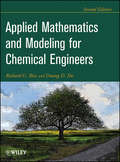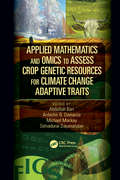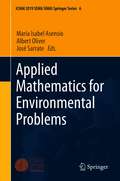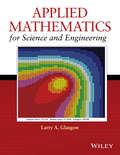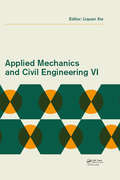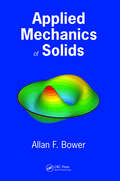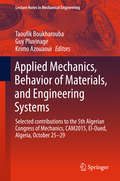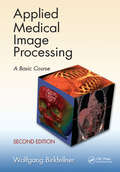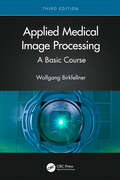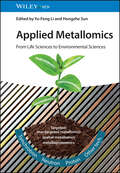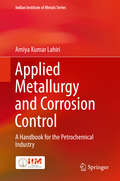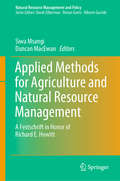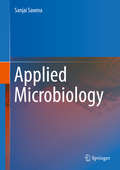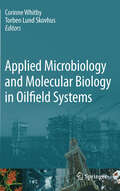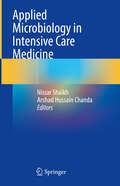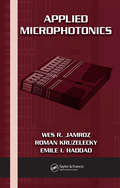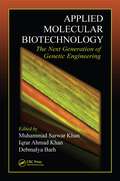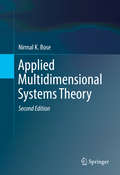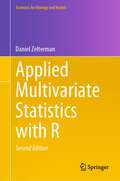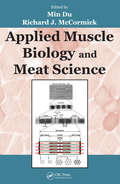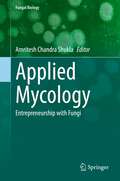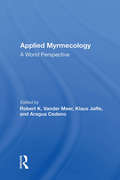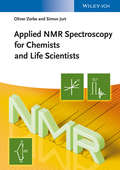- Table View
- List View
Applied Mathematics And Modeling For Chemical Engineers: Solutions Manual (Chemical Engineering Ser.)
by Duong D. Do Richard G. RiceThis Second Edition of the go-to reference combines the classical analysis and modern applications of applied mathematics for chemical engineers. The book introduces traditional techniques for solving ordinary differential equations (ODEs), adding new material on approximate solution methods such as perturbation techniques and elementary numerical solutions. It also includes analytical methods to deal with important classes of finite-difference equations. The last half discusses numerical solution techniques and partial differential equations (PDEs). The reader will then be equipped to apply mathematics in the formulation of problems in chemical engineering. Like the first edition, there are many examples provided as homework and worked examples.
Applied Mathematics and Modeling for Chemical Engineers
by Duong D. Do Richard G. Rice James E. ManevalUnderstand the fundamentals of applied mathematics with this up-to-date introduction Applied mathematics is the use of mathematical concepts and methods in various applied or practical areas, including engineering, computer science, and more. As engineering science expands, the ability to work from mathematical principles to solve and understand equations has become an ever more critical component of engineering fields. New engineering processes and materials place ever-increasing mathematical demands on new generations of engineers, who are looking more and more to applied mathematics for an expanded toolkit. Applied Mathematics and Modeling for Chemical Engineers provides this toolkit in a comprehensive and easy-to-understand introduction. Combining classical analysis of modern mathematics with more modern applications, it offers everything required to assess and solve mathematical problems in chemical engineering. Now updated to reflect contemporary best practices and novel applications, this guide promises to situate readers in a 21st century chemical engineering field in which direct knowledge of mathematics is essential. Readers of the third edition of Applied Mathematics and Modeling for Chemical Engineers will also find: Detailed treatment of ordinary differential equations (ODEs) and partial differential equations (PDEs) and their solutions New material concerning approximate solution methods like perturbation techniques and elementary numerical solutions Two new chapters dealing with Linear Algebra and Applied StatisticsApplied Mathematics and Modeling for Chemical Engineers is ideal for graduate and advanced undergraduate students in chemical engineering and related fields, as well as instructors and researchers seeking a handy reference.
Applied Mathematics and Omics to Assess Crop Genetic Resources for Climate Change Adaptive Traits
by Abdallah Bari, Ardeshir B. Damania, Michael Mackay and Selvadurai DayanandanApplied Mathematics and Omics to Assess Crop Genetic Resources for Climate Change Adaptive Traits focuses on practical means and approaches to further the use of genetic resources for mitigating the effects of climate change and improving crop production. Genetic diversity in crop plants is being further explored to increase yield, disease resistance, and nutritional value by employing recent advances in mathematics and omics technologies to promote the adaptation of crops to changing climatic conditions. This book presents a broad view of biodiversity and genetic resources in agriculture and provides answers to some current problems. It also highlights ways to provide much-needed information to practitioners and innovators engaged in addressing the effects of global climate change on agriculture. The book is divided into sections that cover: The implications of climate change for drylands and farming communities The potential of genetic resources and biodiversity to adapt to and mitigate climate change effects Applications of mathematics and omics technologies Genomics and gene identification We are in the midst of significant changes in global climates, and its effects are already being felt throughout the world. The increasing frequency of droughts and heat waves has had negative impacts on agricultural production, especially in the drylands of the world. This book shares the collective knowledge of leading scientists and practitioners, giving readers a broader appreciation and heightened awareness of the stakes involved in improving and sustaining agricultural production systems in the face of climate change.
Applied Mathematics for Environmental Problems (SEMA SIMAI Springer Series #6)
by María Isabel Asensio Albert Oliver José SarrateThis book contains some contributions presented at the Applied Mathematics for Environmental Problems minisymposium during the International Congress on Industrial and Applied Mathematics (ICIAM) held July 15-19, 2019 in Valencia, Spain. The first paper addresses a simplified physical wildfire spread model, based on partial differential equations solved with finite element methods and integrated into a GIS to provide a useful and efficient tool. The second paper focuses on one of the causes of the unpredictable behavior of wildfire, fire-spotting, through a statistical approach. The third paper addresses low -level wind shear which represents one of the most relevant hazards during aircraft takeoff and landing. It presents an experimental wind shear alert system that is based on predicting wind velocities obtained from the Harmonie-Arome model. The last paper addresses the environmental impact of oil reservoirs. It presents high-order hybridizable discontinuous Galerkin formulation combined with high-order diagonally implicit Runge-Kutta schemes to solve one-phase and two-phase flow problems through porous media. All the contributions collected in this volume are interesting examples of how mathematics and numerical modelling are effective tools in the field of environmental problems.
Applied Mathematics for Science and Engineering
by Larry A. GlasgowPrepare students for success in using applied mathematics for engineering practice and post-graduate studies * moves from one mathematical method to the next sustaining reader interest and easing the application of the techniques * Uses different examples from chemical, civil, mechanical and various other engineering fields * Based on a decade's worth of the authors lecture notes detailing the topic of applied mathematics for scientists and engineers * Concisely writing with numerous examples provided including historical perspectives as well as a solutions manual for academic adopters
Applied Mechanics and Civil Engineering VI
by Liquan XieApplied Mechanics and Civil Engineering VI includes the contributions to the 6th International Conference on Applied Mechanics and Civil Engineering (AMCE 2016, Hong kong, China, 30-31 December 2016), and showcases the challenging developments in the areas of applied mechanics, civil engineering and associated engineering practice. The book covers a wide variety of topics:- Applied mechanics and its applications in civil engineering;- Bridge engineering;- Underground engineering;- Structural safety and reliability;- Reinforced concrete (RC) structures;- Rock mechanics and rock engineering;- Geotechnical in-situ testing & monitoring;- New construction materials and applications;- Computational mechanics;- Natural hazards and risk, and- Water and hydraulic engineering. Applied Mechanics and Civil Engineering VI will appeal to professionals and academics involved in the above mentioned areas, and it is expected that the book will stimulate new ideas, methods and applications in ongoing civil engineering advances.
Applied Mechanics of Solids
by Allan F. BowerModern computer simulations make stress analysis easy. As they continue to replace classical mathematical methods of analysis, these software programs require users to have a solid understanding of the fundamental principles on which they are based.Develop Intuitive Ability to Identify and Avoid Physically Meaningless PredictionsApplied Mechanics o
Applied Mechanics, Behavior of Materials, and Engineering Systems: Selected contributions to the 5th Algerian Congress of Mechanics, CAM2015, El-Oued, Algeria, October 25 – 29 (Lecture Notes in Mechanical Engineering)
by Taoufik Boukharouba Guy Pluvinage Krimo AzouaouiThis book covers a variety of topics in mechanics, with a special emphasis on material mechanics. It reports on fracture mechanics, fatigue of materials, stress-strain behaviours, as well as transferability problems and constraint effects in fracture mechanics. It covers different kind of materials, from metallic materials such as ferritic and austenitic steels, to composites, concrete, polymers and nanomaterials. Additional topics include heat transfer, quality control and reliability of structures and components. Furthermore, the book gives particular attention to new welding technologies such as STIR welding and spray metal coating, and to novel methods for quality control, such as Taguchi design, fault diagnosis and wavelet analysis. Based on the 2015 edition of the Algerian Congress of Mechanics (Congrès Algérien de Mécanique, CAM), the book also covers energetics, in terms of simulation of turbulent reactive flow, behaviour of supersonic jet, turbulent combustion, fire induced smoke layer, and heat and mass transfer, as well as important concepts related to human reliability and safety of components and structures. All in all, the book represents a complete, practice-oriented reference guide for both academic and professionals in the field of mechanics.
Applied Medical Image Processing: A Basic Course
by Wolfgang BirkfellnerA widely used, classroom-tested text, Applied Medical Image Processing: A Basic Course delivers an ideal introduction to image processing in medicine, emphasizing the clinical relevance and special requirements of the field. Avoiding excessive mathematical formalisms, the book presents key principles by implementing algorithms from scratch and usin
Applied Medical Image Processing: A Basic Course
by Wolfgang BirkfellnerA widely used, classroom-tested text, Applied Medical Image Processing: A Basic Course delivers an ideal introduction to image processing in medicine, emphasizing the clinical relevance and special requirements of the field. Avoiding excessive mathematical formalisms, the book presents key principles by implementing algorithms from scratch and using simple MATLAB®/Octave scripts with image data and illustrations on an accompanying companion website. Organized as a complete textbook, it provides an overview of the physics of medical image processing and discusses imaging physics, clinical applications of image processing, image formats and data storage, intensity transforms, filtering of images and applications of the Fourier transform, three-dimensional spatial transforms, volume rendering, image registration, tomographic reconstruction and basic machine learning.This Third Edition of the bestseller: Contains a brand-new chapter on the basics of machine learning Devotes more attention to the subject of color space Includes additional examples from radiology, internal medicine, surgery, and radiation therapy Incorporates freely available programs in the public domain (e.g., GIMP, 3DSlicer, and ImageJ) when applicable Beneficial to students of medical physics, biomedical engineering, computer science, applied mathematics, and related fields, as well as medical physicists, radiographers, radiologists, and other professionals, Applied Medical Image Processing: A Basic Course, Third Edition is fully updated and expanded to ensure a perfect blend of theory and practice.Wolfgang Birkfellner studied theoretical physics at, and holds a Ph.D in medical physics from, the University of Vienna, Austria. Currently, he is heading the Digital Image Processing Laboratory at the Center for Biomedical Engineering and Physics at the Medical University of Vienna. He is also a reviewer and editorial board member for major journals in the field, program committee member for international conferences, and principal investigator for several third-party funded research projects. Previously, he served as senior researcher at the University Hospital Basel/Switzerland and associate professor of medical physics at the Center for Biomedical Engineering and Physics of Vienna Medical School.
Applied Metallomics: From Life Sciences to Environmental Sciences
by Hongzhe Sun Yu-Feng LiApplied Metallomics A groundbreaking survey of a field that unites the sciences The metallome of a cellular compartment, such as an enzyme, is the variety and arrangement of its metal ions. Metallomics is the multidisciplinary study of the metallome and its many important interactions with biological molecules and systems. It exists at the intersection of biochemistry and materials science, offering crucial insights into biological processes in which iron, for instance, plays a pivotal role. Applied Metallomics is an up-to-the-minute overview of research developments in metallomics, offering both analysis and applications in a vast array of scientific and industrial areas. Moving freely between material science, environmental science, health science, and more, it offers a comprehensive survey of this interdisciplinary research area. As the field of metallomics continues to develop and its applications expand, this book will only be a need of the hour Applied Metallomics readers will also find: Detailed treatment of nanometallomics, environmetallomics, agrometallomics, and many more Coverage of machine learning and artificial intelligence techniques with applications in metallomics An author team with vast international research experiences Applied Metallomics is ideal for researchers in many areas touched by metallomics, that include chemistry, biochemistry, biotechnology, bioinorganic chemistry, and more.
Applied Metallurgy and Corrosion Control: A Handbook for the Petrochemical Industry (Indian Institute of Metals Series)
by Amiya Kumar LahiriThis book serves as a comprehensive resource on metals and materials selection for the petrochemical industrial sector. The petrochemical industry involves large scale investments, and to maintain profitability the plants are to be operated with minimum downtime and failure of equipment, which can also cause safety hazards. To achieve this objective proper selection of materials, corrosion control, and good engineering practices must be followed in both the design and the operation of plants. Engineers and professional of different disciplines involved in these activities are required to have some basic understanding of metallurgy and corrosion. This book is written with the objective of servings as a one-stop shop for these engineering professionals. The book first covers different metallic materials and their properties, metal forming processes, welding, and corrosion and corrosion control measures. This is followed by considerations in material selection and corrosion control in three major industrial sectors, oil & gas production, oil refinery, and fertilizers. The importance of pressure vessel codes as well as inspection and maintenance repair practices have also been highlighted. The book will be useful for technicians and entry level engineers in these industrial sectors. Additionally, the book may also be used as primary or secondary reading for graduate and professional coursework.
Applied Methods for Agriculture and Natural Resource Management: A Festschrift in Honor of Richard E. Howitt (Natural Resource Management and Policy #50)
by Siwa Msangi Duncan MacEwanThis book assesses recent developments in the analysis of agricultural policy and water resource management, and highlights the utility and theoretical rigor of quantitative methods for modeling agricultural production, market dynamics, and natural resource management. In diverse case studies of the intersection between agriculture, environmental quality and natural resource sustainability, the authors analyze economic behavior - both at aggregate as well as at individual agent-level - in order to highlight the practical implications for decision-markers dealing with environmental and agricultural policy. The volume also addresses the challenges of doing robust analysis with limited data, and discusses the appropriate empirical approaches that can be employed. The studies in this book were inspired by the work of Richard E. Howitt, Emeritus Professor of Agricultural Economics at the University of California at Davis, USA, whose career has focused on the application of robust empirical methods to address concrete policy problems.
Applied Microbiology
by Sanjai SaxenaThe book is oriented towards undergraduates science and engineering students; postgraduates and researchers pursuing the field of microbiology, biotechnology, chemical - biochemical engineering and pharmacy. Various applications of microorganisms have been covered broadly and have been appropriately reflected in depth in 12 different chapters. The book begins with an insight to the diverse niche of microorganisms which have been explored and exploited in development of various biotechnological products and green processes. Further, how these microorganisms have been genetically modified to improve the desired traits for achieving optimal production of microbially derived products is discussed in the second chapter. Major route of production of microbially derived products and processes is through fermentation technology and therefore due emphasis on different aspects of fermentation technology has been given in the subsequent chapter. The development and deployment of biopesticides and biofertilizers which find tremendous application have been separately discussed under agricultural applications. Application of microbes for the removal of pollutants, recovery of metals and oils has also been discussed under environmental applications. The role of microbial systems in development of fermented foods and beverages have also been discussed in Chapter 6. The application of microbes in production of commodity chemicals and fine chemicals has also been discussed in separate chapters. A chapter has been dedicated to the tremendous applications of microbially produced enzymes in different industrial sectors. Another unique facet of this book is explaining the different methods by which desired traits of microorganisms have been improved for their efficacious and economical exploitation in the industry. A chapter is dedicated to exploitation of microorganisms in development of vaccines for human and veterinary use. Finally, the last chapter discusses the role of immobilization in optimization of industrial processes and development of microbial biosensors for industrial applications. Thus, this book is a holistic approach providing information on the present applications of microorganisms.
Applied Microbiology and Molecular Biology in Oilfield Systems: Proceedings from the International Symposium on Applied Microbiology and Molecular Biology in Oil Systems (ISMOS-2), 2009
by Torben Lund Skovhus Corinne WhitbyApplied Microbiology and Molecular Biology in Oil Field Systems addresses the major problems microbes cause in oil fields, (e.g. biocorrosion and souring) and how beneficial microbial activities may be exploited (e.g. MEOR and biofuels). The book describes theoretical and practical approaches to specific Molecular Microbiological Methods (MMM), and is written by leading authorities in the field from both academia and industry. The book describes how MMM can be applied to faciliate better management of oil reservoirs and downstream processes. The book is innovative in that it utilises real industrial case studies which gives useful technical and scientific information to researchers, engineers and microbiologists working with oil, gas and petroleum systems.
Applied Microbiology in Intensive Care Medicine
by Nissar Shaikh Arshad Hussain ChandaThis book covers microbiological features of the diseases that require intensive care support, including iatrogenic and hospital-acquired infections. The knowledge will assist in the early diagnosis and treatment of bacterial, viral, and fungal infections requiring critical care admission to improve patient outcomes. All microbiological and therapeutic concerns and management of infectious disorders of all human body systems, from the brain to the musculoskeletal system, are addressed. It also describes practical and descriptive ways to prevent, diagnose, and manage various known and forthcoming healthcare-associated illnesses, ranging from MRSA to VRE and others. Applied Microbiology in Intensive Care Medicine will benefit not only intensive and critical care practitioners but also infectious disease practitioners and physicians, surgeons, intensivists, clinical pharmacists, nurses, and technicians in intensive care units.
Applied Microphotonics (Optical Science and Engineering)
by Wes R. Jamroz Roman Kruzelecky Emile I. HaddadAs the limits of electrical performance come within sight, photons are poised to take over for the electron. But the search continues for the materials, topologies, and fabrication technologies capable of producing photonic devices at a reasonable speed and cost. Taking a fundamentallook at the development of photonic technology from the macro- to the microscale, Applied Microphotonics introduces the major principles and technologies underlying the field.Following an overview of historical and commercial driving forces, the authors briefly review the underlying physics, emphasizing the practical and design implications for photonic systems. This general discussion lays the foundation for the remainder of the book, where the authors first introduce the photonic node and then discuss each subsystem in detail, including transmitters, couplers and switches, multiplexers and demultiplexers, receivers, amplifiers, and compensators. The following chapters explore new technologies such as photonic band gap structures, materials and fabrication processes, integration methodologies, and advanced devices such as photonic computers. The book concludes with a brief introduction to quantum photonics and a forward look at potential directions of photonics. Applied Microphotonics encapsulates the recent push toward all-optical networks and devices with an applications-oriented perspective. It is ideal for newcomers to the field as well as anyone curious to know how photonic technology can benefit their own field.
Applied Molecular Biotechnology: The Next Generation of Genetic Engineering
by Iqrar Ahmad Khan Debmalya Barh Muhammad Sarwar KhanApplied Molecular Biotechnology: The Next Generation of Genetic Engineering explains state-of-the-art advances in the rapidly developing area of molecular biotechnology, the technology of the new millennium. Comprised of chapters authored by leading experts in their respective fields, this authoritative reference text:Highlights the latest omics-ba
Applied Multidimensional Systems Theory
by Nirmal K. BoseRevised and updated, this concise new edition of the pioneering book on multidimensional signal processing is ideal for a new generation of students. Multidimensional systems or m-D systems are the necessary mathematical background for modern digital image processing with applications in biomedicine, X-ray technology and satellite communications. Serving as a firm basis for graduate engineering students and researchers seeking applications in mathematical theories, this edition eschews detailed mathematical theory not useful to students. Presentation of the theory has been revised to make it more readable for students, and introduce some new topics that are emerging as multidimensional DSP topics in the interdisciplinary fields of image processing. New topics include Groebner bases, wavelets, and filter banks.
Applied Multiple Regression/Correlation Analysis for the Behavioral Sciences Third Edition
by Jacob Cohen Patricia Cohen Stephen G. West Leona S. AikenA textbooks for behavioral scientists in statistics.
Applied Multivariate Statistics with R (Statistics for Biology and Health)
by Daniel ZeltermanNow in its second edition, this book brings multivariate statistics to graduate-level practitioners, making these analytical methods accessible without lengthy mathematical derivations. Using the open source shareware program R, Dr. Zelterman demonstrates the process and outcomes for a wide array of multivariate statistical applications. Chapters cover graphical displays; linear algebra; univariate, bivariate and multivariate normal distributions; factor methods; linear regression; discrimination and classification; clustering; time series models; and additional methods. He uses practical examples from diverse disciplines, to welcome readers from a variety of academic specialties. Each chapter includes exercises, real data sets, and R implementations. The book avoids theoretical derivations beyond those needed to fully appreciate the methods. Prior experience with R is not necessary.New to this edition are chapters devoted to longitudinal studies and the clustering of large data. It is an excellent resource for students of multivariate statistics, as well as practitioners in the health and life sciences who are looking to integrate statistics into their work.
Applied Muscle Biology and Meat Science
by Richard J. McCormick Min DuKnowledge of muscle biology is continuing to expand in the animal and food sciences industry, especially the understanding of the mechanisms that control skeletal muscle development, growth, and their impacts on meat production and quality. Applied Muscle Biology and Meat Science provides agriculturalists with state-of-the-art information and a platform to further explore this specialized topic. It also gives novices a comprehensive knowledge base in applied muscle biology and meat science. Many existing problems in meat science and production are due to a lack of understanding of the underlying biological mechanisms of the livestock. Careful to avoid gory processing details, the text focuses on biological changes and the appropriate manage
Applied Mycology: Entrepreneurship with Fungi (Fungal Biology)
by Amritesh Chandra ShuklaFungi are an important link in the food webs of all ecosystems. They have immense potential and comprise a myriad of useful bioactive compounds. Fungi feature in a wide range of diverse processes and applications in modern agriculture, the food science industry, and the pharmaceutical industry. In the food and drink arena, the role of fungi is historically important in the form of mushrooms and in fermented foods as yeasts for baking and brewing. These roles are supplemented by the use of fungal food processing enzymes and additives, and more recently in the development of protein-based foodstuffs from fungi. Additionally, they are used in the formulation of biofertilizers and biopesticides used as biostimulants and bioprotectants of crops. The practical use of newer techniques such as genetic recombination and robotics have revolutionized the modem agricultural biotechnology industry, and have created an enormous range of possible further applications of fungal products.Myco-materials created from mycelia (the root-like parts of fungi) are gaining attention as a sustainable alternative for a wide range of materials. They are being used as insulation, sustainable packaging, foam inserts, and even "eco-leather.” In fact, mycelium bricks are pound-for-pound stronger than concrete. In addition, medicinal uses of fungal species have been historically recorded as important agents in the pharmaceutical sciences. The potential for myco-materials seems limitless. The field of mycology and its application has become an increasingly important component in the education of industrial biotechnology. This book on applied mycology provides information helpful for developing entrepreneurial opportunities with fungi. This volume explains both the basic science and the applications of mycology and bio-resource technology with special emphasis on entrepreneurial applications. It offers a complete, one-stop resource for those interested in microbiology, food and agricultural science, medical mycology, and for those in industrial biotechnology.
Applied Myrmecology: A World Perspective (Westview Studies In Insect Biology)
by Robert K Vander MeerAnts have always fascinated the nature observer. Reports from ancient Egypt and Mesopotamia indicate that ants interested humans long ago. Myrmecology as a science had its beginning in the last century with great naturalists like Andre, Darwin, Emery, Escherich, Fabre, Fields, Forel, Janet, Karawaiew, McCook, Mayr, Smith, Wasmann and Wheeler. They studied ants as an interesting biological phenomenon, with little thought of the possible beneficial or detrimental effects ants could have on human activities (see Wheeler 1910 as an example). When Europeans began colonizing the New World, serious ant problems occurred. The first reports of pest ants came from Spanish and Portuguese officials of the fifteenth and sixteenth centuries in Trinidad, The West Indies, Central America and South America. Leaf-cutting ants were blamed for making agricultural development almost impossible in many areas. These ants, Atta and Acromyrmex species, are undoubtedly the first ants identified as pests and may be considered to have initiated interest and research in applied myrmecology (Mariconi 1970).
Applied NMR Spectroscopy for Chemists and Life Scientists
by Oliver Zerbe Simon JurtFrom complex structure elucidation to biomolecular interactions - this applicationoriented textbook covers both theory and practice of modern NMR applications.Part one sets the stage with a general description of NMR introducing important parameters such as the chemical shift and scalar or dipolar couplings. Part two describes the theory behind NMR, providing a profound understanding of the involved spin physics, deliberately kept shorter than in other NMR textbooks, and without a rigorous mathematical treatment of all the physico-chemical computations. Part three discusses technical and practical aspects of how to use NMR. Important phenomena such as relaxation, exchange, or the nuclear Overhauser effects and the methods of modern NMR spectroscopy including multidimensional experiments, solid state NMR, and the measurement of molecular interactions are the subject of part four. The final part explains the use of NMR for the structure determination of selected classes of complex biomolecules, from steroids to peptides or proteins, nucleic acids, and carbohydrates.For chemists as well as users of NMR technology in the biological sciences.
